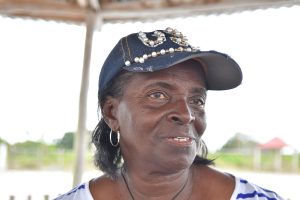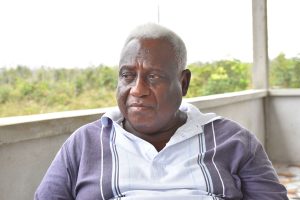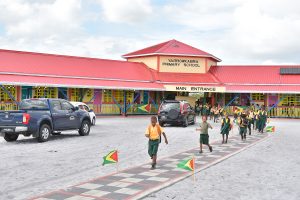– Residents praise gov’t for boost in infrastructures
AFTER years of neglect, Yarrowkabra – a community located on the Soesdyke-Linden Highway – is experiencing major transformation as government takes steps to boost its infrastructures.

Thirty-nine years ago when Edward Benjamin moved to Yarrowkabra, the heavily vegetated community was without basic infrastructure. “There was no road, no school, nothing,” the retired policeman said while pointing out that it was former President, Linden Forbes Sampson Burnham, who had established the community. “We came here on a self-help basis through our leader, Forbes Burnham. He took us out of the office and brought us here to build our own homes, and when the houses were finished, he said give the people water and light; we were the first to get water and light here… about 14 or 15 of us,” he recalled.
Though several of his colleagues have migrated, Benjamin, who will celebrate his 90th birthday next month, told the Guyana Chronicle that after many years of neglect, he is pleased to see that Yarrowkabra is finally being developed.
Chairman of the Community Development Council (CDC), Corrine Wilson explained that it was in 2017 that Yarrowkabra–a community with a population of approximately 5000 persons–got its first set of asphalted roads, a primary school and an expanded water and electrification programme. “Last year was a bumper year for Yarrowkabra. 2017, that’s when we actually got all of these facilities, roads, schools, water, and electricity,” she posited.

In October, 2016, the A Partnership for National Unity + Alliance for Change (APNU+AFC) Government allocated $90.8 million for the construction of asphalted roads in the community. The main roads leading in and out of Yarrowkabra are now paved. Prior to the completion of the road project, the main roads in the community were of sand.
Wilson, who has been living in Yarrowkabra for the past 20 years, said the multi-million dollar primary school, which was completed in 2017, is also a major plus for the community. “We have a nursery school but this (primary) school really brought out a lot of children. Before, the children had to walk to school to Dora or Kuru Kururu, or Kuru Kuru College, but now we have about 160 children attending the Yarrowkabra Primary School,” she explained.
Yarrowkabra is located four miles away from Kuru Kuru, and in the case of Dora, the community is six miles away. It was noted that prior to the construction of the primary school, there were times when parents opted to keep their children at home because they were unable to send them to school. Wilson said more children are attending school now because it is in close proximity to their homes.
The Yarrowkabra Primary School was constructed at a cost of $12M through a loan from the Caribbean Development Bank (CDB). It was built to accommodate 300 children, and comprises sanitary facilities, a canteen, and a staff room for teachers.

Additionally, in 2017, the Guyana Power and Light (GPL) and the Guyana Water Incorporated (GWI) initiated expansion programmes in the community. The CDC Chairperson explained that while some residents had access to water and electricity, the majority was without. The electrification project is ongoing, and it is expected that within a few months, more of the residents will be supplied with electricity.
Though thankful for the projects executed in recent times, Wilson believes that there is much more work to be done. “We have accomplished a lot of things…but we are not fully there,” she told this newspaper.
This year, she said residents will be lobbying the government for a hospital and a police station to be constructed in Yarrowkabra. According to Wilson, the population of the community has outgrown the health post, noting that while the doctor and two nurses do their best, it is only so much they can do.
In the absence of a hospital, the Ministry of Health would facilitate medical outreaches to attend to the health needs of the community. However, Wilson believes that it is time the community gets its own hospital. Last week, a medical outreach was conducted in the community by a team of 20 local and international physicians and according to the CDC Chairman, approximately 136 persons turned up for medical attention.
Police protection

The community is also without a police station or police outpost. “We need a police station or a police outpost in Yarrowkabra because that station (Highway Police Outpost) was really a traffic outpost…They said they make it into an all-purpose station, but when people go there to make reports for things like domestic abuse, they still send them to Soesdyke and Timehri and some of the cases drop because people don’t have money to go so far, so they drop it,” she explained.
Yarrowkabra once had an active Community Policing Group (CPG) but its lone vehicle was sent to another location, stalling its operation. But while the construction of a hospital and a police station in the community may be long term projects, the CDC Chairman said she would like to see an Information Communication Technology (ICT) hub established in Yarrowkabra as promised.
It was explained that last year, government announced that the community would benefit from the establishment of an ICT hub but even though a building was identified, the project has not kicked off. “The building is there; it had power, but the power was taken away from the building last year because of non-compliance, payment,” Wilson further explained. To date, the problem has not been rectified. “A lot of children have school assignments, SBAs and they would have to do those things till in Soesdyke or put a plan on their phones just to get the internet,” Wilson said while explaining the situation faced by the secondary school students and even those attending primary school.
Ayudele Olutunde, another community leader, said it is his desire to see the ICT hub established and fully functional. “The ICT hub…it is being held back because the building has no electricity. The first thing I would like to see is electricity put to that building…,” Olutunde told this newspaper. Like Wilson, Olutunde said the ICT hub would be a facility that school-aged children and even adults will be able to utilise for educational purposes. As a leader of the community, he has written to several ministers of government and authorities to have the issues affecting residents addressed. On Sunday, the residents of Yarrowkabra would meet to discuss the future development of the community. It is Olutunde’s hope that a recreational facility be established in addition to a demonstration farm where the different methods of farming can be explored.



.jpg)











